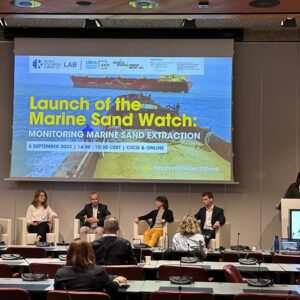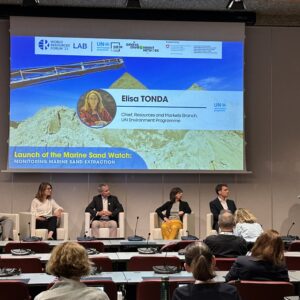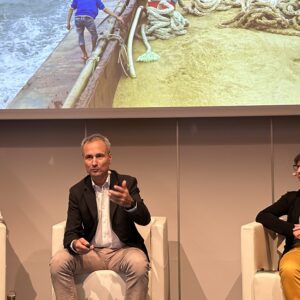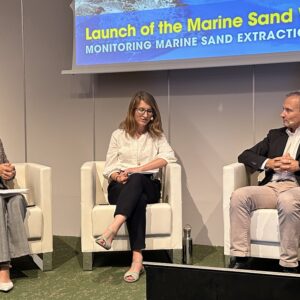Event Conference
Launch of the Marine Sand Watch: Monitoring Marine Sand Extraction | WRF23 Lab

06 Sep 2023
14:00–15:30
Venue: CICG | Plenary B & Online | Webex
Organization: UNEP Global Resource Information Database Geneva, Geneva Environment Network
This lab event, included in the programme of the 2023 edition of the World Resource Forum, launched the Marine Sand Watch, a global data platform that tracks and monitors sand extraction in the marine environment. By making estimates on extractions and locations available for all, the goal is to increase transparency and dialogue between industry, governments, and civil society. The event, organized by UNEP/GRID-Geneva and the Geneva Environment Network discussed steps to identify good practices on extracting standards and environmental policies.

About this Event
Currently, sand resources are not monitored globally. Marine sand – sand and gravel in the ocean and coastal environment – is an important environmental asset. It links and protects marine and terrestrial ecosystems, enhances coastal resilience against storms, protects coastal aquifers from salination and supports biodiversity, fisheries, and other blue economy activities. Most of the dredging activities include excavating, transporting and disposing of sand via large vessels, in order to dredge for construction materials, reclaim land, deepen waterways and build harbours, remove polluted sediments, replenish beaches, build coastal defenses, and support offshore energy infrastructure.
UNEP has been calling for better monitoring of sand extraction and use, the ban of sand extraction for the purpose of mining sand as a resource in the active beach-nearshore sand system and to establish an international standard on sand extraction in the marine environment.
At this event, UNEP/GRID-Geneva will be launching the Marine Sand Watch, a global platform designed to monitor large vessels engaged in dredging activities in the marine environment. Marine Sand Watch receives support from the University of Geneva and funding from the Swiss Federal Office for the Environment. The platform builds on research that UNEP/GRID-Geneva has been conducting with its research partners, Global Fishing Watch, the University of California Santa Barbara, and Google.
By making estimates of extractions and locations available for all, the goal of the platform is to increase transparency, push for better management of sand resources, and engage with the dredging sector to reduce environmental impact through higher standards. The event, organized by UNEP/GRID-Geneva and the Geneva Environment Network showcased the platform, discuss the need for better monitoring, and steps to identify good practices and implement higher standards.
Background on UNEA Resolution 5/12
The United Nations Environment Assembly has requested: “UNEP/GRID-Geneva centre to strengthen scientific, technical and policy knowledge with regard to sand, and to support global policies and action regarding the environmentally sound extraction and use” (UNEP/EA.5/Res.12 ). Member states at the last World Conservation Congress organized by IUCN have also voted the motion 33 “for the urgent global management of marine and coastal sand resources”, these three international mandates are showing the increased interest and concerns for the issue of sand and sustainability.
About the World Resources Forum
The World Resources Forum 2023 Rethinking Value – Resources for Planetary Wellbeing, hosted by the Swiss Federal Office for the Environment and in collaboration with the United Nations Environment Programme, is taking place at CICG and online, from 4 to 6 September 2023. This edition acts as a platform bringing together stakeholders from industry, policy, civil society and research to co-create and share innovative solutions to the triple planetary crisis and enable wellbeing for all within planetary boundaries.
WRF’23 will focus on three conference tracks with a high-potential for transforming systems towards sustainability:
- Sufficiency: from a consumer to a sufficient society
- Value Chains: from extractive to regenerative value chains
- Digitalisation: from growth to purpose
Speakers
By order of intervention.

Elisa TONDA
Chief, Resources and Markets Branch, UN Environment Programme

Pascal PEDUZZI
Director, UNEP/GRID-Geneva

Laura PLATCHKOV
National Focal Point (UNEA5/12), Federal Office for the Environment, Switzerland

Vera VAN LANCKER
Marine Geologist, Royal Belgian Institute of Natural Sciences

Arnaud VANDER VELPEN
Sand industry & Data Analytics Officer, UNEP/GRID-Geneva

Stephanie CHUAH
Programme Officer, UNEP/GRID-Geneva | Moderator
Summary
Opening
Elisa Tonda | Chief, Resources and Markets Branch, United Nations Environment Programme | Moderator
- Minerals and metals play a central role in enabling the transition to green and low-carbon economies and to the achievement of the SDGs. As countries are accelerating their efforts into that transition, we must ensure that the extraction of natural resources is not augmenting the stress on people and on the environment.
- Research is reminding us that a lot of the resources that might be needed for accelerating these transitions are located in contexts with high environmental, social and governance complexities.
- UNEP has concentrated its attention on the high-impact sector, where the improvement in practices and policies can yield significant benefits in addressing the triple planetary crisis of climate, biodiversity and pollution.
- Conversations around sands and gravel are not capturing as much attention as other resources (lithium, cobalt…). Although the dredging of sand can have an important impact on biodiversity, sand is a very important resource for coastal protection and an important asset in climate adaptation. Attention on sand has been growing over time and in fact, in 2020 the countries at the IUCN Congress called for urgent action for the management of marine and coastal sand including the stop of all illegal sand mining activities.
- The resolution approved by the UNEA5 in March 2022 (UNEP/EA.5/Res.12 ) requests to strengthen the scientific, technical and policy knowledge with regards to sand extraction and use. That same resolution brought us to convene an intergovernmental consultation to identify at a regional scale and at an international scale which issues were relevant for poor countries globally.
- On 7 and 8 September 2023, countries will convene for a Global Consultation on Minerals and Metals to further discuss and deepen the conversation around issues that have been raised at the regional level, including sand.
Stephanie CHUAH | Programme Officer, UNEP/GRID-Geneva | Moderator
The Marine Sand Watch is the world’s first data platform designed to monitor large dredging vessels engaged in dredging activities in the marine environment around the globe. Sand is becoming a very strategic material but it also causes a multitude of environmental impacts, becoming one of the more urgent social economic issues of the 21st century.
Presentation of the Sand Marine Watch
Pascal PEDUZZI | Director, UNEP/GRID-Geneva
Origins of the Marine Sand Watch Platform
- The idea of monitoring the sand in the marine environment was initiated in 2019 and its main goal is to make the invisible visible. We are not aware of how much sand we are using as there is very little awareness of the importance of sand in everyday objects, infrastructure and activities. Sand is the invisible hero of our development, it is everywhere.
- A 2020 article published in the journal Nature exposed the fact that the weight of dry biomass of the entire vegetation has been surpassed by that of human-built materials. Concretes, roads, bricks all together weigh more than the dry biomass of the entire vegetation of planet Earth and sand is at the core of the vast majority of these.
- There is a tension between the use of sand as a construction material for infrastructures and for its services in the natural environment. Sand is the elephant in the room of development and of the energy transitions, but sand is also a fundamental building block for ecosystems, biodiversity and climate stability. Sand is fundamental for fisheries, for the protection of shorelines, protecting us from storm surge and preventing saltly infiltration of water. Extraction of sand is making people more vulnerable to climate change and of impairing the tourism industry by damaging beaches.
- We are extracting 50 billion of sand per year globally, part of which is sediment gravel while 4-8 billion tons of those sediments are extracted from the marine environment. This platform is being launched to unveil this data that was formerly unmapped.
- The topic of sand extraction gained momentum since the 2019 Fourth United Nations Environment Assembly (UNEA-4) passed a resolution on mineral resource governance (UNEP/EA.4/Res.19). This was followed by IUCN’s call for the urgent global management of marine and coastal and resources. Since 2022, UNEP/GRID-Geneva received by UNEA the mandate to strengthen the scientific, technical and policy knowledge on sand use and send extraction.
Policy and Scientific Information on Sand Extraction
- Sand can be extracted from static environments, such as quarries, but it can also be extracted from dynamic areas like beaches, marine environments or river flows, where it interacts with the environment. Sand extraction alters the marine environment in multiple ways. The mechanical instruments used resembles a giant vacuum cleaner that sterilizes the bottom of the ocean. Among these impacts, the crunching of microorganisms kills them and reduces them into small particles, which in turn change the turbidity of the waters creating a plume.
- Other impacts include coarse material being dumped on other organisms, boat noises and potential coastal erosion.
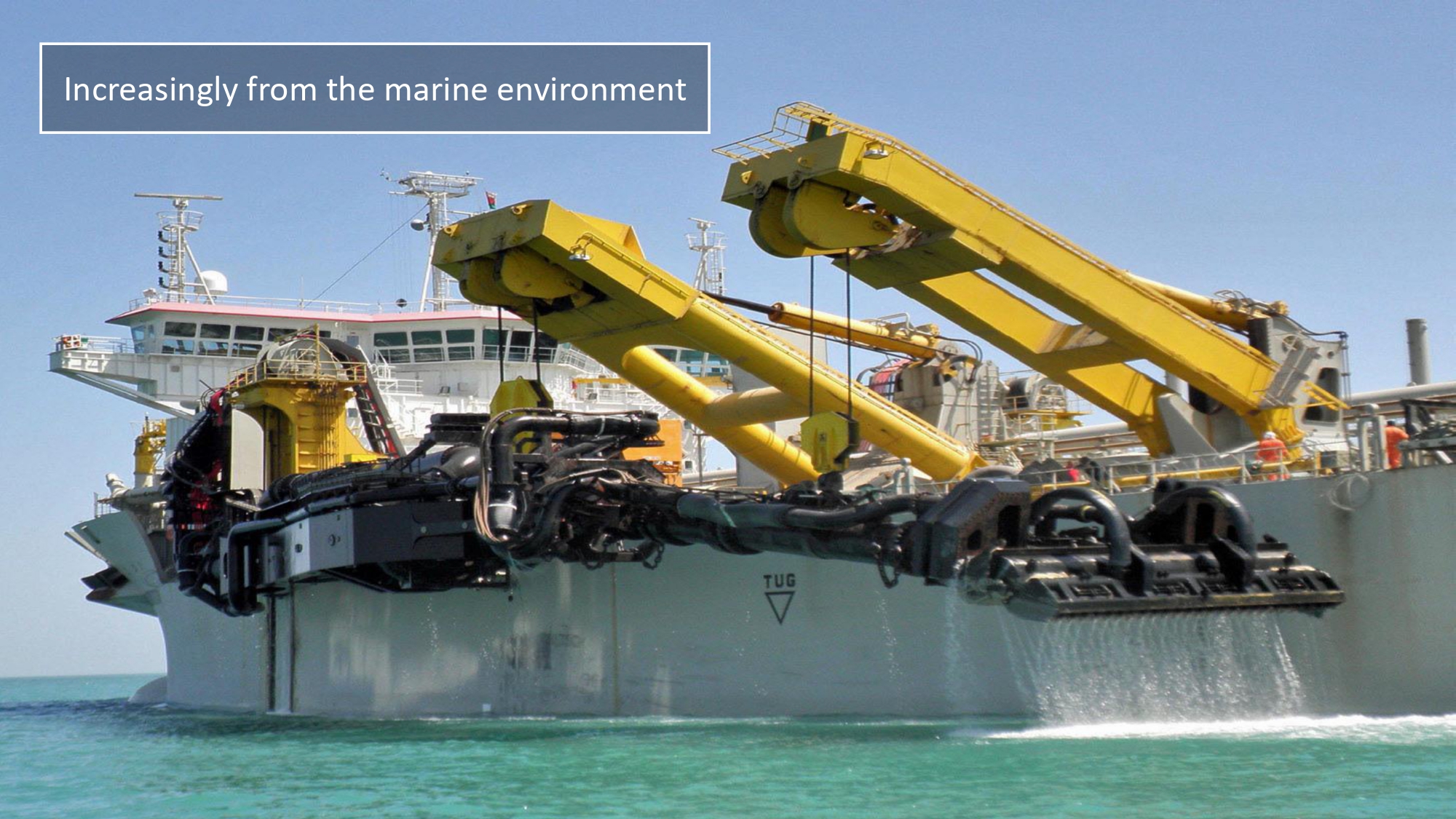

Marine Sand Watch Monitoring
- Each large vessels emits radio signals called automated identification system (AIS), which allows to spot their movement, which is different from those of fishing boats for instance. When dredging vessels go back and forth it is possible to understand whether they are dredging, and the signal allows identifying the boat, how long dredging has been going on, their destination and more.
- We have been training an artificial intelligence to detect those movements automatically since 2012, allowing the collection of huge amounts. After analyzing this data, it is now possible to know where this sand has been taken, the total amount by location, how much volume percent, the number of operators or companies and and vessels have been operating in a specific region.
- Each year, rivers send to the ocean around 10-16 billion tons of sediments and humans are extracting around half of it (six billion tons per year), corresponding to building a wall of 10 meter by 10 meter all around planet Earth every year; or using two kilograms per day per person for all the 8 billion people or more.
- The amount taken is already mind-blowing and it might be even larger as small boats are not equipped with AIS signals and cannot be tracked. The aim of the global sand observatory is to find more invisible stuff, including terrestrial sand, and make it visible.
- For the time being, we have been monitoring the marine environment. For instance, in West Africa, the impact of coastal degradation in 2017 amounted to 3.8 billions dollars and it was mostly linked to sand extractions, while also the Mekong River in China is also over-extracted and leading to land erosion.
Marine Sand Watch Platform
The content of this section can be browsed through the Marine Sand Watch Storymap
- The interactive mapping platform is composed of various layers that allow zooming into different locations, allowing to see what and where people are extracting sand; where boats are offloading sand, and the movement of the trucks moving them.
- It is possible to watch all kinds of activities in terms of dredging, maintenance, and extractions and to link them to new construction activities, like harbor infrastructure in Bahrain and Sri Lanka, the creation of artificial islands, and the expansion of Singapore’s territories; the creation of new beaches and harbor infrastructure in West Africa and so on.
- We have been monitoring worldwide sand extraction and we are now aware of the amounts being extracted in the marine environment per country and we will further continue this data processing to continue making the invisible visible.
Panel Discussion
Laura PLATCHKOV | National Focal Point (UNEA5/12), Federal Office for the Environment, Switzerland
- The Marine Sand Watch is a very innovative tool that can support countries across the globe, and it will more transparency on this topic.
- Like any country, Switzerland consumes lots of sand. Sand contributes to about 40 percent of Switzerland’s material footprints. Sand, gravel, and other non-metallic minerals are largely mined in Switzerland, but despite this the growing demand expected for meeting the energy transition will not only challenge our production model but puts pressure on the environment, climate and landscape. In Switzerland, sand is used for infrastructure, construction, and sectors like glass, computers and cars. Many of the goods Switzerland imports have an environmental impact abroad.
- These reasons motivate Switzerland’s international commitment on sustainable management of minerals, alongside with our constitutional mandate to protect natural resources nationally and internationally.
- Sand serves as habitat for various species, especially in coastal environments, and is also key for climate mitigation and adaptation, meaning that sand extraction can also disturb the climate regulatory function of the ocean, making this commitment coherent also with our engagement in other areas such as the climate and biodiversity.
- The issue of sand and gravel is increasingly making it on the global policy agenda, from the four UNEA resolutions adopted in recent years – two relating to minerals and the other two relating to sustainable infrastructure. Switzerland was very active in all these and has initiated with other countries UNEA5/12 resolution on environmental aspects of minerals and metals, which makes important references to sand.
- Throughout the consultations for the implementation of this resolution, Member States were vocal on needs with respect to sand, including increased awareness about its impacts, the need for more data collection and analysis, technical expertise, improved monitoring and better assessment of environmental impacts. The Marine Sand Watch is a tool launched timely to respond to many needs that were expressed.
- Since the Marine Sand Watch is publicly available it can be useful for governments and for the industry for the financial sector as well. It could also be part of a bigger initiative: the Global Sand Observatory, an idea that has been also discussed as part of the UNEA Process related to resolution 5/12. A Global Sand Observatory should connect stakeholders and could help gather data beyond the marine environment. These instruments can provide critical inputs to improved frameworks and policies.
Vera VAN LANCKER | Marine Geologist, Royal Belgian Institute of Natural Sciences
- The Marine Sand Watch will be very valuable in bringing data and information together and it will unveil how little we know globally about the seafloor. Initiatives like Seabed 2030 aim at mapping in sufficient detail the entire ocean by 2030, but by now we are very marginally building the knowledge up. In the Northern Emisphere the European Marine Observation and Data Network, has been progressively mapping since 2009 human activities, biology, and geology. Despite the progress made by such initiatives, global-level progress is still marginal.
- We also need to recognize that there are areas with no maps at all and show the need for training, capacity building, and scaling up of the whole mapping process. There is a global urgency to accelerate in this sense because we will face increasing demands and in many sectors that will require sand and other materials, making sand a transboundary issue.
- In Belgium, we were able to map the quality and the quantity of our sand reserves. In spite of the many data uncertainties, it represents a good basis for understanding both the quality and quantity of sand.
- Case studies like the Belgium one show that is possible to conduct mapping and are really paving the way for more mapping of the seabed. By bringing these data together in the Marine Sand Watch platform it will become clear where we are, and what true data gaps we are facing
- We are currently faced with the concurring need to extract less and use more sand. With more data available, extracting less and better can be possible. With the Marine Sand Watch, data from studies and observations can be centralized.
- For the minimization of risk, we must build on science as much of the impacts are slow and low amplitude, so this also means that there is a need for more detail but also a much wider perspective on the interconnectedness of everything. Of course, this goes beyond the capacity of a single country, making expertise-sharing a global requirement.
Arnaud VANDER VELPEN | Sand industry & Data Analytics Officer, UNEP/GRID-Geneva
Three drivers pushed us to start with this project.
- The need of a capacity-building tool, because we noticed that although there are countries that are monitoring their exclusive economic zone on sand mining and dredging activities, the vast majority of countries do not have sufficient capacity to monitor these activities. The Marine Sand Watch wishes to support countries in understanding what kind of dredging activities are taking place in their exclusive economic zone or in the vicinity of their coastlines.
- Bringing stakeholders together identifying best practices, creating the information and the data to talk about transboundary issues.
- Working towards a minimum environmental standard. Currently, sand sources we tap into will most likely be the cheapest but therefore not the most environmentally sustainable: by creating transparency and providing data and information we can open this discussion.
Now that the platform has been launched, to fully enforce these three aspects additional capabilities and capacities are required. Currently, the platform covers the period 2012 – 2019. In the upcoming months, we want to show that we can go from 2012 to 2023, but for this platform to come its full potential in the mid-long term we would like to move to near real-time observation of dredging vessels.
Q&A
Q: Will the map be matched with any anti-dredging or sustainable dredging policies? How would you expect individual countries to collaborate in the platform? Will you to proactively reach out to them or should countries ask for technical support and policy recommendations?
Pascal PEDUZZI: The platforms is now the hands of countries as we completed the task of delivering a tool that was mandated by UNEA. If a country has no capability to monitor what’s going on in their maritime environment, they now have the possibility to know what’s going on in terms of fishing for example, thanks to the Global Fishing Watch. It is now possible to monitor if vessels fish their waters and if they agree for it. Countries can have the same opportunity with the Marine Sand Watch. Once we will achieve further development of the platform and go to near real-time, we could support countries monitoring whether dredging sand concessions are respected, whether unauthorized activities are taking place. This is possible because we have the names of the vessels and of the operators, and we can infer the volume they are taking. So, these are ways we can support countries in monitoring their own resources. If we grab sand too quickly and too much, the cumulative impact will last forever.
A ton of sand can cost between three to twelve dollars depending on the country, but the environmental value of the sand service in protecting our shoreline against erosion, against the impact of sea level rise on salinations of aquifers on fisheries and support as a habitat for all the finishing industry and for the biodiversity, is incalculable. For all these services we need countries to distinguish between the price and the value as the monetary value we currently give to sand will be a cumulative price for hundreds or thousands of years.
Sand also comes, in smaller quantities, from rivers. In all the major rivers those sediments get trapped on the way and do not reach the shore. Plus, sand is dredged out of rivers and we need to develop tools to monitor it as the problem is becoming more and more dire, with all major rivers in Asia for example being mined for sand.
The platform is trying to asses would a shortage of sand entails for beaches’ protection, shorelines, and biodiversity. Further work is necessary to not only shed light on what is not known, but also on what the best practices and standards, and regulations are. This will be part of the conservation we will have with countries we collaborate with.
Q: There currently is a new project for passing gas through the Island of Antigua through a pipe that will involve dredging. Could your artificial intelligence be able to zoom in on the island of Antigua and Bermuda?
Arnaud VANDER VELPEN: If the activities employ large vessels, that are obliged to use AIS, it is possible for the Marine Sand Watch Platform to monitor them. Their various activities are something that we are able to interpret and identify currently, we are able to follow about 50 percent of large dredging fleets, which includes large vessels. There are one or two likelihoods that let us see what is going on in Antigua. The International Association of Dredging Companies published the document Sand as a resource: Best practices to conduct responsible dredging projects, we think the beauty of this interaction between stakeholders on the ground, the industry and the space that we provide is that these interactions are possible and so the data will be online and will you the ability to put the data next to the best practices and to create your narrative from that.
Q: South Africa is witnessing on its West Coast mining operations to find diamonds, which are often land-based and not dredging, are these part of the activities you monitor?
Arnaud VANDER VELPEN: There are some dredging activities as well for highly valuable minerals of the West Coast, possibly in South Africa and Namibia. These are things that are not integrated into the platform yet but it hopefully will be in the future since dredging sand to retrieve highly valuable minerals and then dumping what remains back at the sea has important environmental impacts For the on-land parts, ongoing projects include land degradation and mining also in collaboration between GRID-Geneva and the relevant conventions, such as the United Nations Convention to Combat Desertification (UNCCD) which are looking at the issue of mining, including coastal mining.
Q: How is the platform regulated in the Exclusive Economic Zone?
Vera VAN LANCKER: Within the European Marine Strategy Framework Directive, each member state has to monitor its environmental status and report every six years. One of the descriptors of good environmental status is seafloor integrity and for that there are indicators that demand member states to quantify physical disturbance and loss. Generally speaking, and depending on the type of environment aggregate, extraction can be classified as long as it does not lead to loss or habitat modification or entails taking biogenic habitats directly. If extraction leads to changes from sand to mud and to changes the course substrate, habitat loss will take place. In the Marine Study Framework Directive (MSFD) cycle, there is a novel plea to a threshold of two percent loss per broad-scale habitat. Member states are forced to pin down their monitoring efforts and to increase the knowledge of the habitats that are also partly being dredged. Beyond Europe, environmental regulations exist in the United States and Southern Australia. The Marine Sand Watch platform will contribute to bringing all these regulations together and inform the minimum standards that will be worked on by experts and by combined with data or informed by data.
Arnaud VANDER VELPEN: When we are interacting with stakeholders and ask for best practices, its always is the same number of countries that have put in place a certain policy framework that forces the industry to adhere to a minimum environmental standard or a minimum environmental requirement. There is vast room for improving policy frameworks across the world based on the experiences of those countries that have them already in place.
Q: How do you see the platform working in Asia? Is there a specific country in Asia that you would like to link to the topic of sand extraction?
Arnaud VANDER VELPEN: Over the past two decades, various advancements have been enacted in Southeast Asia and East Asia. For instance, Japan has completely changed its dredging practices and China has taken certain steps forward when it comes to river dredging. Nevertheless, these efforts are limited to the national level and it is not transformed into policy improvement that can be replicated elsewhere. The ecosystem of one country is not the ecosystem of another country. In certain countries the sand is mainly to be found in the dynamic area in other countries the sand can be found in fossilized sand dunes, there is a context to be given and there are many things to exchange upon.
Q: When can the comparison to the flow of sediment from rivers be made? What is actually showcased on the platform?
Pascal PEDUZZI: In spite of their size, small boats are numerous but they cannot be integrated in the statistics as they do not use AIS. In developing countries, is the informal sector that brings most of the sand, and in Asia dredging in the rivers environment. These motivated us to cover other types of practices than just those large vessels. That is the first step in the right direction, we commenced monitoring what those vessels are doing and can already shed light on that one, but small boats and practices from the informal sector are a reason of concern. We have seen what the impact in Asia on ecosystems on rivers were flows and riverbank erosions, and it is the numerous but small actors that are adding a large impact on the environment. We are increasingly witnessing this phenomenon in Africa as well. The African continent’s population will double by 2050, increasing the need of resources to build roads, dams, schools, hospitals and so on. Currently, the demand for sand and gravels is satisfied by the informal sector, which gathers it from dynamic settings such as rivers, beaches and shallow sea environments for it is easier transportation-wise. We could work with the International Labour Organization(ILO) on how to transform this informal sector into a more formal one, as these people need investments, hardware and tools that are economically unexpected. These are necessary for moving people from mining sand from beaches, rivers, and shallow marine areas to queries. To support this shift, governments must be more proactive.
During the regional consultation for the African content part of the UNEA 5/12 resolution implementation that took place in Dakar, every single African country mentioned the issues they’ve got with sand and their lack of capacity to deal with that. According to a World Bank report, 5.4 percent of the GDP of all the western African countries is affected by coastal degradation and this is induced by the mining of sand in the marine and in the beach environment. The Marine Sand Watch will be moving towards monitoring small boats, rivers mining and so on, in spite of the difficulties it could be done through remote sensing, science, using indirect statistics.
Arnaud VANDER VELPEN: The amount of sediment that is brought from mountain to sea is linked as these are dynamic environments. The marine area is one of the most important matrixes because the more material is taken out of rivers, the less there will be in the marine environment. We have observed in many regions that the amount of material exceeds the one that is naturally generated, for which it is important to talk about the sediment budget.
What can be currently seen on the platform are the different types of extraction conducted by dredging vessels. For the trailing suction, we have done a more advanced analysis of what sand concessions are allotted, which maintaining channels support it, and where is it used for creating new infrastructure, which we call capital dredging. For the most common type of vessel, it is possible to see on the platform whether is it creating new infrastructure or else. Of course, we also show the dredging activity of all types of dredging vessels and explain the vessel type involved.
Q: The aforementioned IUCN resolution included demands for measures to stop all illegal sand mining activities. Does this platform help tracking where illegal activities take place?
Pascal PEDUZZI: It does in the case of vessels emitting AIS signals that have been dredging outside of concessions. We can signal that to countries and help them track down historically activities that occurred from 2012 to 2019 and in the future we hope to be doing that in real time. In the case of vessels that decide to operate illegally and switch off the AIS, we can see vessels disappearing as ghosts and then reappearing repeatedly, it might be the case they have been dredging. Those boats can be put on a blacklist. Those operating illegally are not necessarily doing it for huge profits but might only be doing a very heavy an uneasy job to secure a livelihood. As much as we want illegal dredgin to stop because it is harming the beaches and the environment, our aim is to allow those involved in it to be included in the legal value chain and preserve their livelihood. We must give the nformal sector a boost where they can be moved in extracting sand from queries in the appropriate way.
To monitor sand illegally on the beaches is extremely difficult and dangerous. Dozens of journalists have been killed trying to do so. We have their names, we use them sometimes to pay memory and attention to those families who are paying the deep price of their lives for bringing this information and the truth to reality. The platform’s aim is to make invisible visible but safe.
Closing Remarks
Stephanie CHUAH: How can we move forward when we come to capacity building and how can the Marine Sand Watch support the better management of sand resources?
Laura PLATCHKOV: The Marine sand watch is now up and running, it’s available on internet, and it will be improved and developed further. Still, there are other sources of extraction of sand and other needs. To increase action of those strengthening cooperation, collecting best practices and share those practices is key. This idea is the core of the Global Sand Observatory, which has been discussed among member states following UNEA resolutions. Switzerland would very much welcome the setting up of This Global Sand Observatory. The discussion has to continue because there is a lot to do, there is a lot of more knowledge, a lot of needs and gaps in this area. At the 2024 Sixth UNEA Assembly, these discussions will progress further as member states will deep-dive on the issue of minerals. It is very important that the discussion continues on an international level.
Pascal PEDUZZI: The issues connected to sand are just another example of the problematic relationship we have with natural resources and this is why discussions like the World Resources Forum are important. We thought we had an infinite amount of forest, but it’s not the case as deforestation is ongoing, but having tools for monitoring deforestation and that is spreading light on those practices. The Global Fishing Watch was set up to monitor the fisheries we are depleting with overfishing. There are many resources issue to be addressed are they are all tight to our problematic production and consumption practices. We are at the beginning of tackling the overlooked issue of sand
Few generations from now people will see we have been placing valuable resources in the trash as what we consider as mining waste is a waste of resources and the amount of sand and rocks that are entailing yearly produce amounting to 30 to 60 billion tons is enough. If all governments could ask their mining industry to do an assessment of what substances are radioactive and full of toxics we would build differently, but if mining waste is clean it could be used for the building industry for instance. Let’s be much wiser about how we do things and how we access resources. Let’s rethink our consumption, it’s not a slight change but a necessary one.
Monitoring is a first step in the right direction but then there is the need to enforce, the need to take action.We can do things differently and there are lots of solutions we provide some example in the report Sand and Sustainability: 10 Strategic Recommendations to Avert a Crisis.
Arnaud VANDER VELPEN: For this platform to be as efficient as possible, it is extremely important for stakeholders to tell us their stories, from best practices to make it more tailored to sharing data.
Vera VAN LANCKER: Regarding capacity building, it is important to re-emphasize that the dialogue should guide the training and capacity building that comes with that. The platform can also be beneficial to students, raising awareness on the little that is known about aggregate extraction.
Highlights
Video
Live from Webex
Live in the Room
Photo Gallery
Links
- Presentations made during the event
- Marine Sand Watch Official Website
- Marine Sand Watch Storymap
- Marine Sand Watch Introductory Video
- Press Conference Marine Sand Watch Launch | 5 September 2023
- Global marine sand watch sneak peek
- UNEA Resolution 5/12
- Sand as a resource: Best practices to conduct responsible dredging projects | International Association of Dredging Companies
- Sand and Sustainability: 10 Strategic Recommendations to Avert a Crisis | Report Launch | Geneva Environment Network Event
- Mineral Resource Governance and the Role of Geneva

